YAMAHA TMAX 2016 Repair Manual
Manufacturer: YAMAHA, Model Year: 2016, Model line: TMAX, Model: YAMAHA TMAX 2016Pages: 110, PDF Size: 6.26 MB
Page 61 of 110
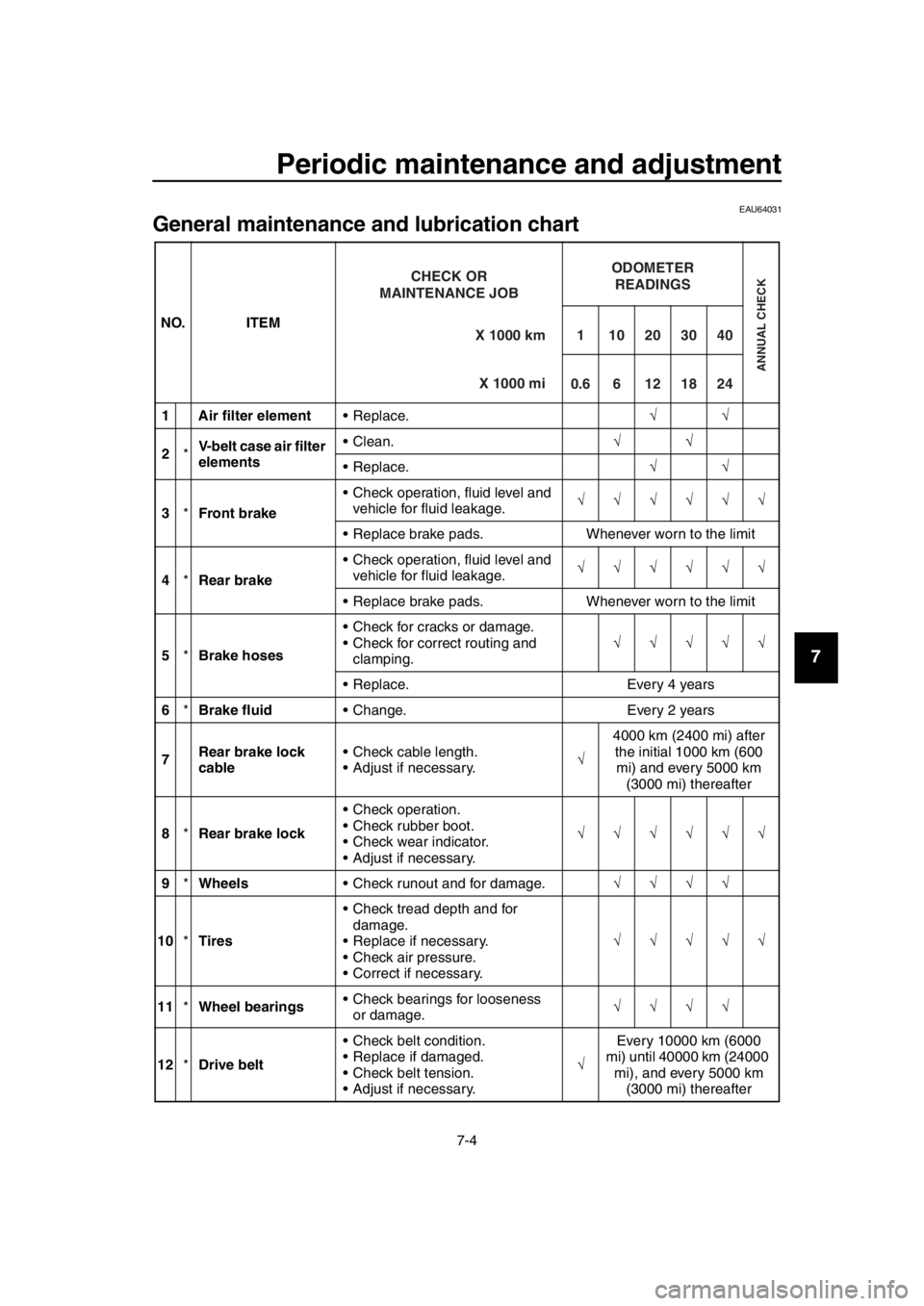
Periodic maintenance and adjustment
7-4
1
2
3
4
5
6
7
8
9
10
11
12
13
14
EAU64031
General maintenance and lubrication chart
NO. ITEM
1 Air filter element Replace.
2 *V-belt case air filter
elements Clean.
Replace.
3 *Front brake Check operation, fluid level and
vehicle for fluid leakage.
Replace brake pads. Whenever worn to the limit
4 *Rear brake Check operation, fluid level and
vehicle for fluid leakage.
Replace brake pads. Whenever worn to the limit
5 *Brake hoses Check for cracks or damage.
Check for correct routing and
clamping.
Replace. Every 4 years
6 *Brake fluid Change. Every 2 years
7 Rear brake lock
cable Check cable length.
Adjust if necessary.
4000 km (2400 mi) after
the initial 1000 km (600 mi) and every 5000 km (3000 mi) thereafter
8 *Rear brake lock Check operation.
Check rubber boot.
Check wear indicator.
Adjust if necessary.
9 *Wheels Check runout and for damage.
10 *Tires Check tread depth and for
damage.
Replace if necessary.
Check air pressure.
Correct if necessary.
11 *Wheel bearings Check bearings for looseness
or damage.
12 *Drive belt Check belt condition.
Replace if damaged.
Check belt tension.
Adjust if necessary. Every 10000 km (6000
mi) until 40000 km (24000 mi), and every 5000 km (3000 mi) thereafterX 1000 km
CHECK OR
MAINTENANCE JOB
X 1000 mi
ODOMETER READINGS
ANNUAL CHECK
110203040
0.66121824
2PW-9-E1.book 4 ページ 2015年9月10日 木曜日 午後5時17分
Page 62 of 110
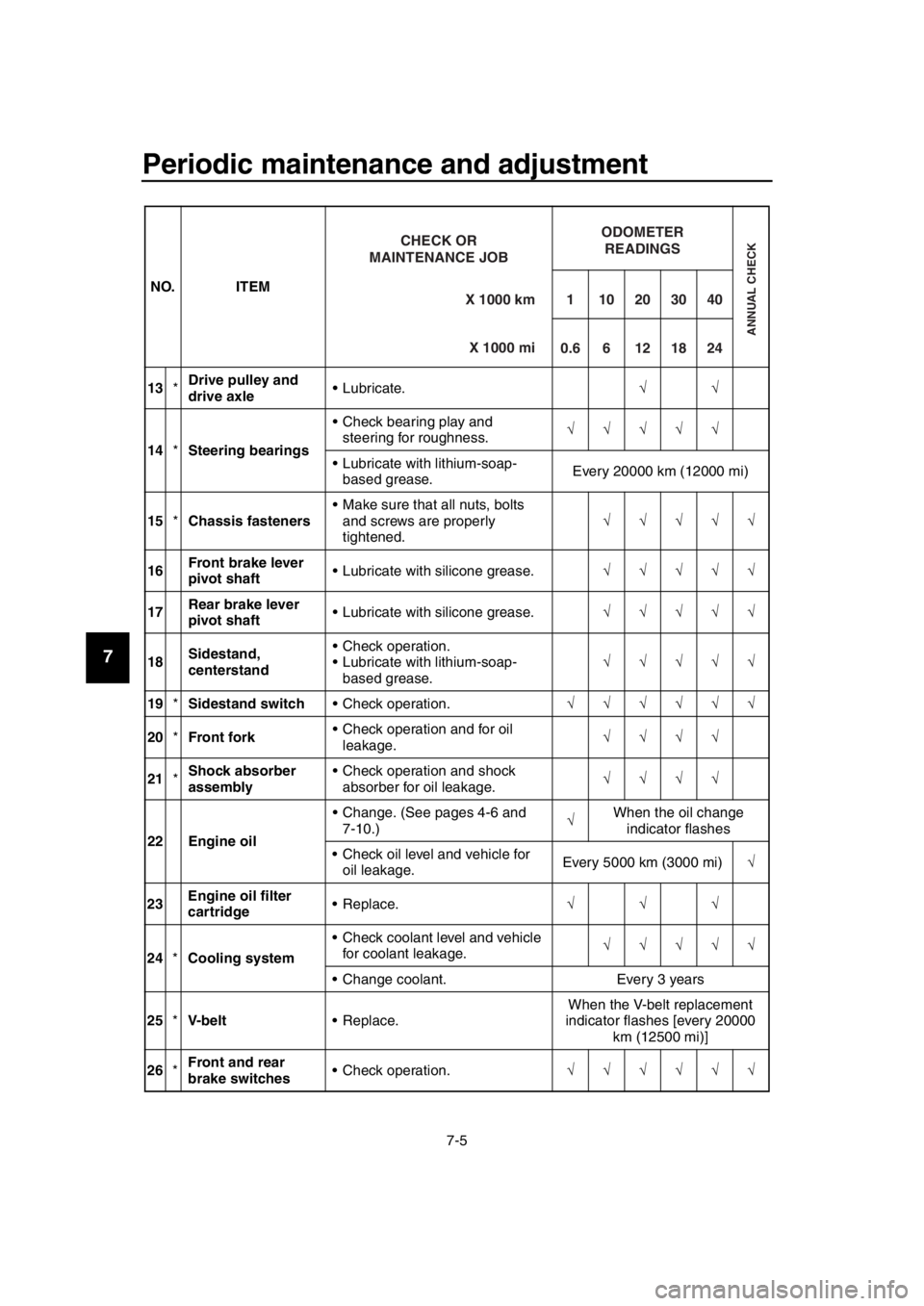
Periodic maintenance and adjustment
7-5
1
2
3
4
5
6
7
8
9
10
11
12
13
14
13 *Drive pulley and
drive axle Lubricate.
14 *Steering bearings Check bearing play and
steering for roughness.
Lubricate with lithium-soap- based grease. Every 20000 km (12000 mi)
15 *Chassis fasteners Make sure that all nuts, bolts
and screws are properly
tightened.
16 Front brake lever
pivot shaft Lubricate with silicone grease.
17 Rear brake lever
pivot shaft Lubricate with silicone grease.
18 Sidestand,
centerstand Check operation.
Lubricate with lithium-soap-
based grease.
19 *Sidestand switch Check operation.
20 *Front fork Check operation and for oil
leakage.
21 *Shock absorber
assembly Check operation and shock
absorber for oil leakage.
22 Engine oil Change. (See pages 4-6 and
7-10.) When the oil change
indicator flashes
Check oil level and vehicle for oil leakage. Every 5000 km (3000 mi)
23 Engine oil filter
cartridge Replace.
24 *Cooling system Check coolant level and vehicle
for coolant leakage.
Change coolant. Every 3 years
25 *V- b e l t Replace. When the V-belt replacement
indicator flashes [every 20000 km (12500 mi)]
26 *Front and rear
brake switches Check operation.
NO. ITEM
X 1000 km
CHECK OR
MAINTENANCE JOB
X 1000 mi
ODOMETER READINGS
ANNUAL CHECK
110203040
0.66121824
2PW-9-E1.book 5 ページ 2015年9月10日 木曜日 午後5時17分
Page 63 of 110

Periodic maintenance and adjustment
7-6
1
2
3
4
5
6
7
8
9
10
11
12
13
14
EAU38263
TIP
Engine air filter and V-belt air filters This model’s engine air fi lter is equipped with a disposable oil-coated paper
element, which must not be cleaned wi th compressed air to avoid damaging
it.
The engine air filter element needs to be replaced and the V-belt air filter el- ements need to be serviced more frequently when riding in unusually wet or
dusty areas.
Hydraulic brake service After disassembling the brake master cylinders and calipers, always change the fluid. Regularly check the brake fluid levels and fill the reservoirs
as required.
Every two years replace the internal components of the brake master cylin-
ders and calipers, and change the brake fluid.
Replace the brake hoses every four years and if cracked or damaged.
27 Moving parts and
cables Lubricate.
28 *Throttle grip Check operation.
Check throttle grip free play,
and adjust if necessary.
Lubricate cable and grip housing.
29 *Lights, signals and
switches Check operation.
Adjust headlight beam.
NO. ITEM
X 1000 km
CHECK OR
MAINTENANCE JOB
X 1000 mi
ODOMETER READINGS
ANNUAL CHECK
110203040
0.66121824
2PW-9-E1.book 6 ページ 2015年9月10日 木曜日 午後5時17分
Page 64 of 110
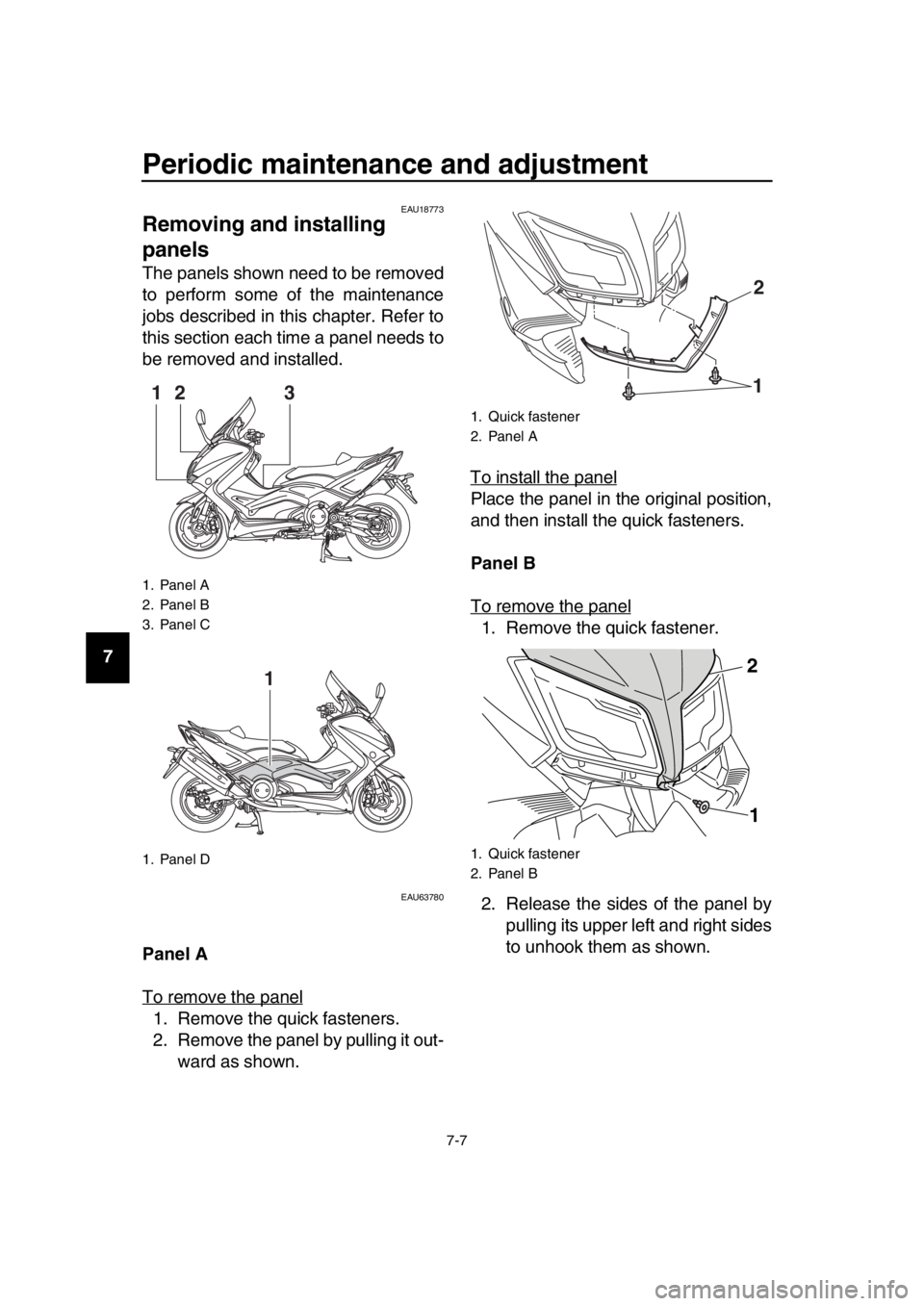
Periodic maintenance and adjustment
7-7
1
2
3
4
5
6
7
8
9
10
11
12
13
14
EAU18773
Removing and installing
panels
The panels shown need to be removed
to perform some of the maintenance
jobs described in this chapter. Refer to
this section each time a panel needs to
be removed and installed.
EAU63780
Panel A
To remove the panel
1. Remove the quick fasteners.
2. Remove the panel by pulling it out- ward as shown. To install the panel
Place the panel in the original position,
and then install the quick fasteners.
Panel B
To remove the panel
1. Remove the quick fastener.
2. Release the sides of the panel by
pulling its upper left and right sides
to unhook them as shown.
1. Panel A
2. Panel B
3. Panel C
1. Panel D
231
1
1. Quick fastener
2. Panel A
1. Quick fastener
2. Panel B
1
2
1
2
2PW-9-E1.book 7 ページ 2015年9月10日 木曜日 午後5時17分
Page 65 of 110
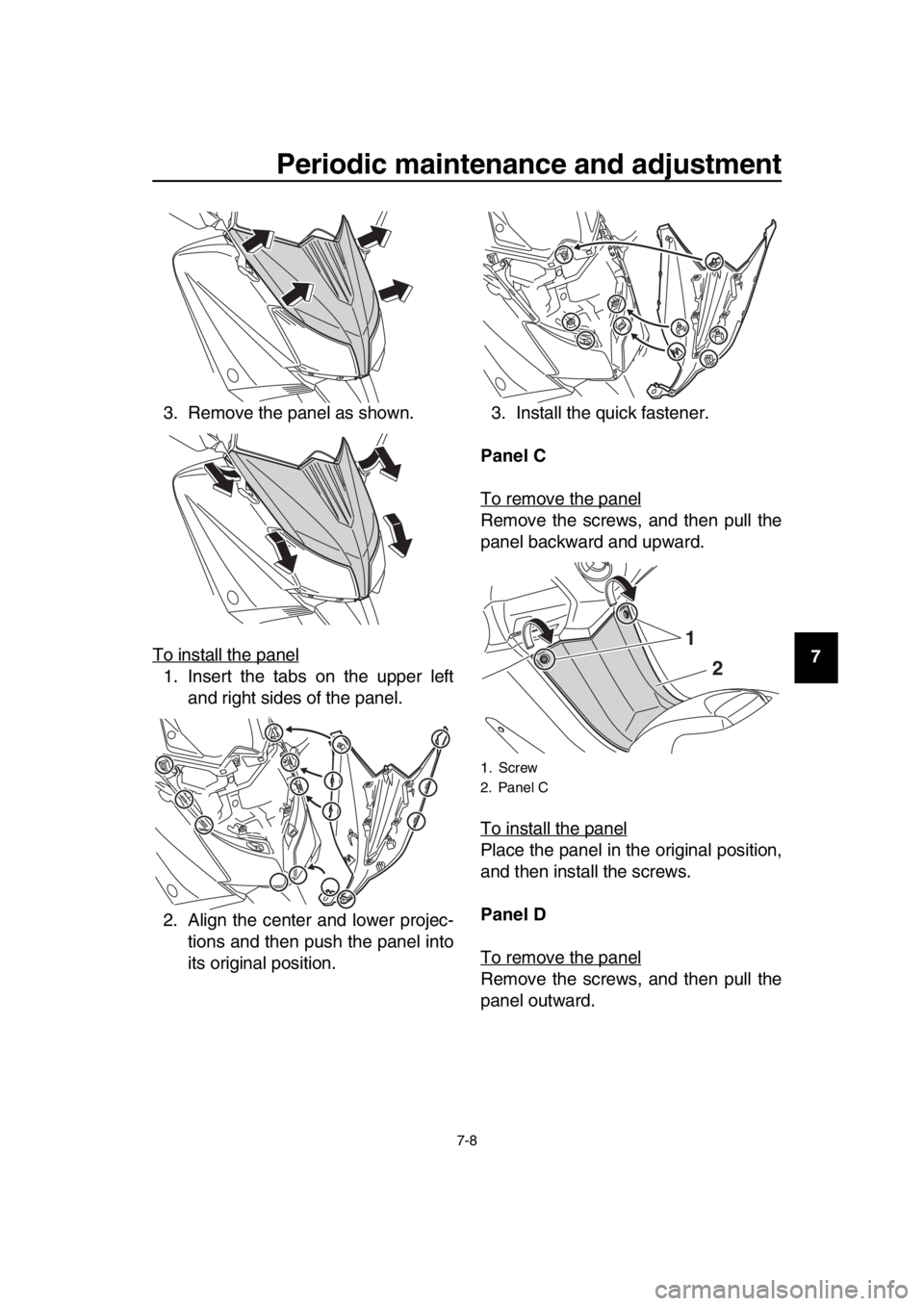
Periodic maintenance and adjustment
7-8
1
2
3
4
5
6
7
8
9
10
11
12
13
14
3. Remove the panel as shown.
To install the panel
1. Insert the tabs on the upper left and right sides of the panel.
2. Align the center and lower projec- tions and then push the panel into
its original position. 3. Install the quick fastener.
Panel C
To remove the panel
Remove the screws, and then pull the
panel backward and upward.
To install the panel
Place the panel in the original position,
and then install the screws.
Panel D
To remove the panel
Remove the screws, and then pull the
panel outward.
1. Screw
2. Panel C
2
1
2PW-9-E1.book 8 ページ 2015年9月10日 木曜日 午後5時17分
Page 66 of 110

Periodic maintenance and adjustment
7-9
1
2
3
4
5
6
7
8
9
10
11
12
13
14 To install the panel
Place the panel in the original position,
and then install the screws.
EAU19643
Checking the spark plugs
The spark plugs are important engine
components, which should be checked
periodically, preferably by a Yamaha
dealer. Since heat and deposits will
cause any spark plug to slowly erode,
they should be removed and checked
in accordance with the periodic mainte-
nance and lubrication
chart. In addition,
the condition of the spark plugs can re-
veal the condition of the engine.
The porcelain insulator around the cen-
ter electrode of each spark plug should
be a medium-to-light tan (the ideal color
when the vehicle is ridden normally),
and all spark plugs installed in the en-
gine should have the same color. If any
spark plug shows a distinctly different
color, the engine could be operating im-
properly. Do not attempt to diagnose
such problems yourself. Instead, have
a Yamaha dealer check the vehicle.
If a spark plug shows signs of electrode
erosion and excessive carbon or other
deposits, it should be replaced.
Before installing a spark plug, the spark
plug gap should be measured with a
wire thickness gauge and, if necessary,
adjusted to specification.
1. Screw
2. Panel D
1
2
1
Specified spark plug:
NGK/CR7E
2PW-9-E1.book 9 ページ 2015年9月10日 木曜日 午後5時17分
Page 67 of 110
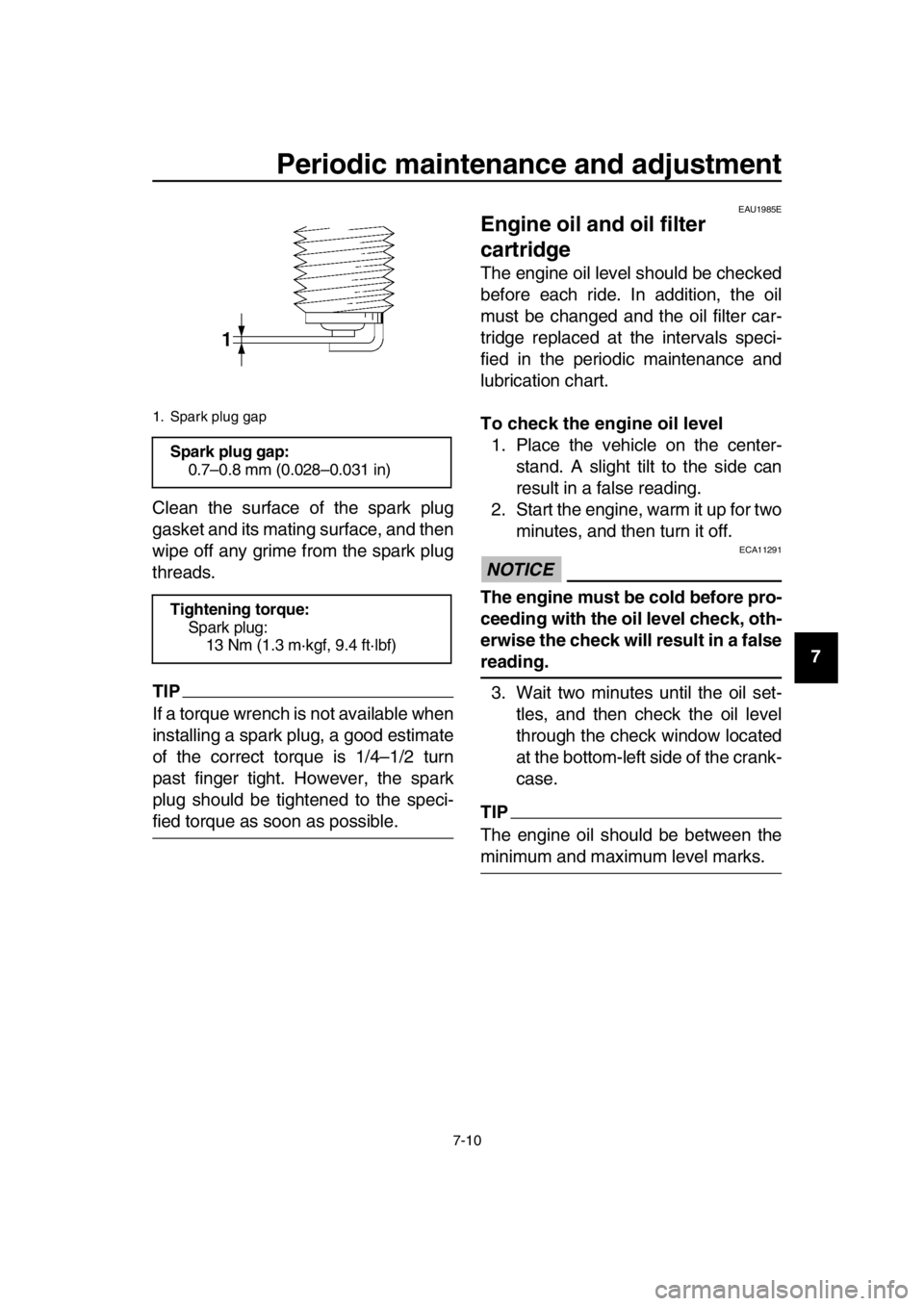
Periodic maintenance and adjustment
7-10
1
2
3
4
5
6
7
8
9
10
11
12
13
14
Clean the surface of the spark plug
gasket and its mating surface, and then
wipe off any grime from the spark plug
threads.
TIP
If a torque wrench is not available when
installing a spark plug, a good estimate
of the correct torque is 1/4–1/2 turn
past finger tight. However, the spark
plug should be tightened to the speci-
fied torque as soon as possible.
EAU1985E
Engine oil and oil filter
cartridge
The engine oil level should be checked
before each ride. In addition, the oil
must be changed and the oil filter car-
tridge replaced at the intervals speci-
fied in the periodic maintenance and
lubrication chart.
To check the engine oil level
1. Place the vehicle on the center- stand. A slight tilt to the side can
result in a false reading.
2. Start the engine, warm it up for two minutes, and then turn it off.
NOTICE
ECA11291
The engine must be cold before pro-
ceeding with the oil level check, oth-
erwise the check will result in a false
reading.
3. Wait two minutes until the oil set- tles, and then check the oil level
through the check window located
at the bottom-left side of the crank-
case.
TIP
The engine oil should be between the
minimum and maximum level marks.
1. Spark plug gap
Spark plug gap:0.7–0.8 mm (0.028–0.031 in)
Tightening torque: Spark plug:
13 Nm (1.3 m·kgf, 9.4 ft·lbf)
2PW-9-E1.book 10 ページ 2015年9月10日 木曜日 午後5時17分
Page 68 of 110
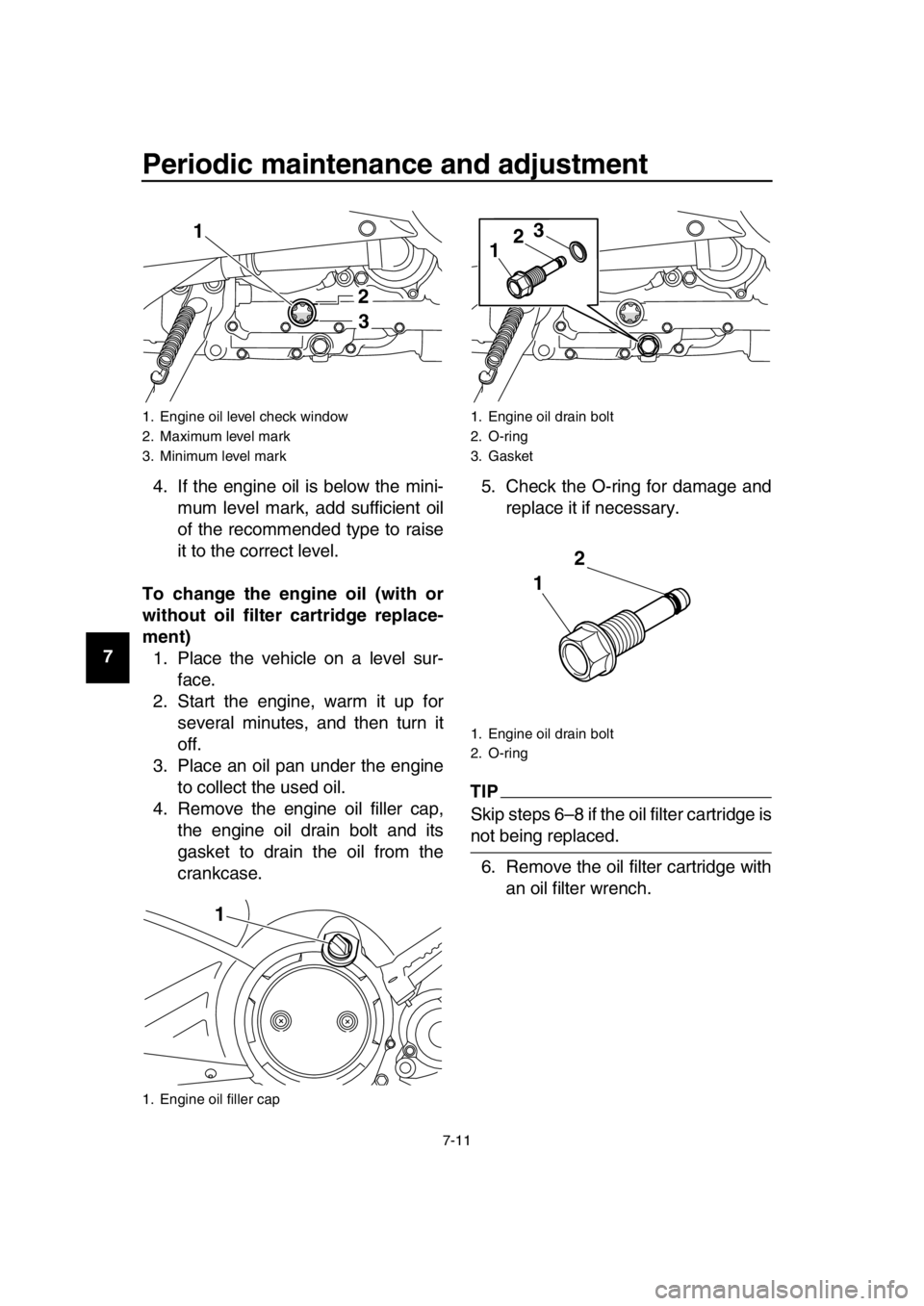
Periodic maintenance and adjustment
7-11
1
2
3
4
5
6
7
8
9
10
11
12
13
14 4. If the engine oil is below the mini-
mum level mark, add sufficient oil
of the recommended type to raise
it to the correct level.
To change the engine oil (with or
without oil filter cartridge replace-
ment) 1. Place the vehicle on a level sur- face.
2. Start the engine, warm it up for several minutes, and then turn it
off.
3. Place an oil pan under the engine to collect the used oil.
4. Remove the engine oil filler cap, the engine oil drain bolt and its
gasket to drain the oil from the
crankcase. 5. Check the O-ring for damage and
replace it if necessary.
TIP
Skip steps 6–8 if the oil filter cartridge is
not being replaced.
6. Remove the oil filter cartridge with an oil filter wrench.
1. Engine oil level check window
2. Maximum level mark
3. Minimum level mark
1. Engine oil filler cap
1
23
1
1. Engine oil drain bolt
2. O-ring
3. Gasket
1. Engine oil drain bolt
2. O-ring
1 2
3
1 2
2PW-9-E1.book 11 ページ 2015年9月10日 木曜日 午後5時17分
Page 69 of 110
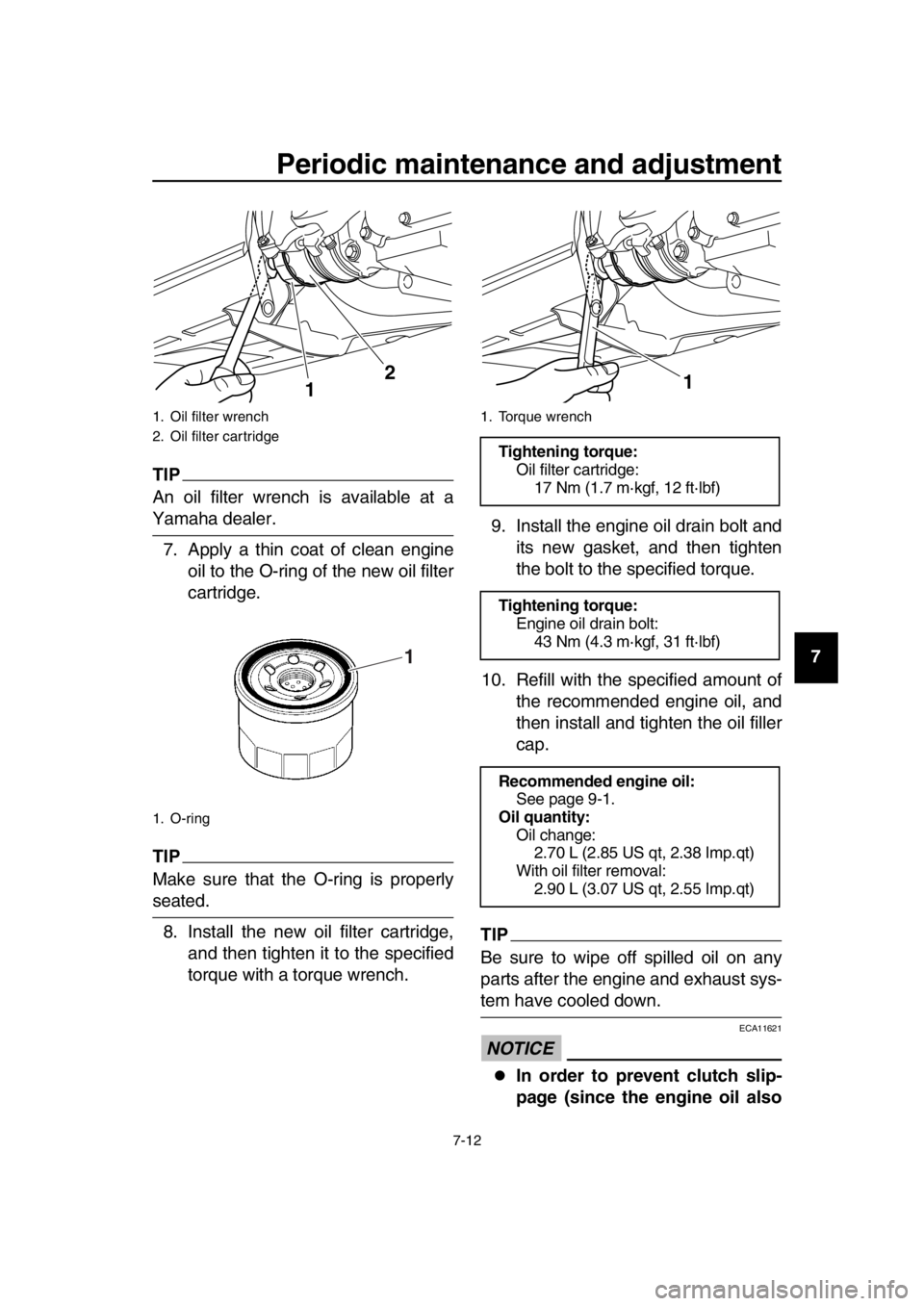
Periodic maintenance and adjustment
7-12
1
2
3
4
5
6
7
8
9
10
11
12
13
14
TIP
An oil filter wrench is available at a
Yamaha dealer. 7. Apply a thin coat of clean engine oil to the O-ring of the new oil filter
cartridge.
TIP
Make sure that the O-ring is properly
seated.
8. Install the new oil filter cartridge, and then tighten it to the specified
torque with a torque wrench. 9. Install the engine oil drain bolt and
its new gasket, and then tighten
the bolt to the specified torque.
10. Refill with the specified amount of the recommended engine oil, and
then install and tighten the oil filler
cap.
TIP
Be sure to wipe off spilled oil on any
parts after the engine and exhaust sys-
tem have cooled down.
NOTICE
ECA11621
In order to prevent clutch slip-
page (since the engine oil also
1. Oil filter wrench
2. Oil filter cartridge
1. O-ring
2
1
1
1. Torque wrench
Tightening torque:
Oil filter cartridge:
17 Nm (1.7 m·kgf, 12 ft·lbf)
Tightening torque: Engine oil drain bolt: 43 Nm (4.3 m·kgf, 31 ft·lbf)
Recommended engine oil: See page 9-1.
Oil quantity: Oil change: 2.70 L (2.85 US qt, 2.38 Imp.qt)
With oil filter removal: 2.90 L (3.07 US qt, 2.55 Imp.qt)
1
2PW-9-E1.book 12 ページ 2015年9月10日 木曜日 午後5時17分
Page 70 of 110
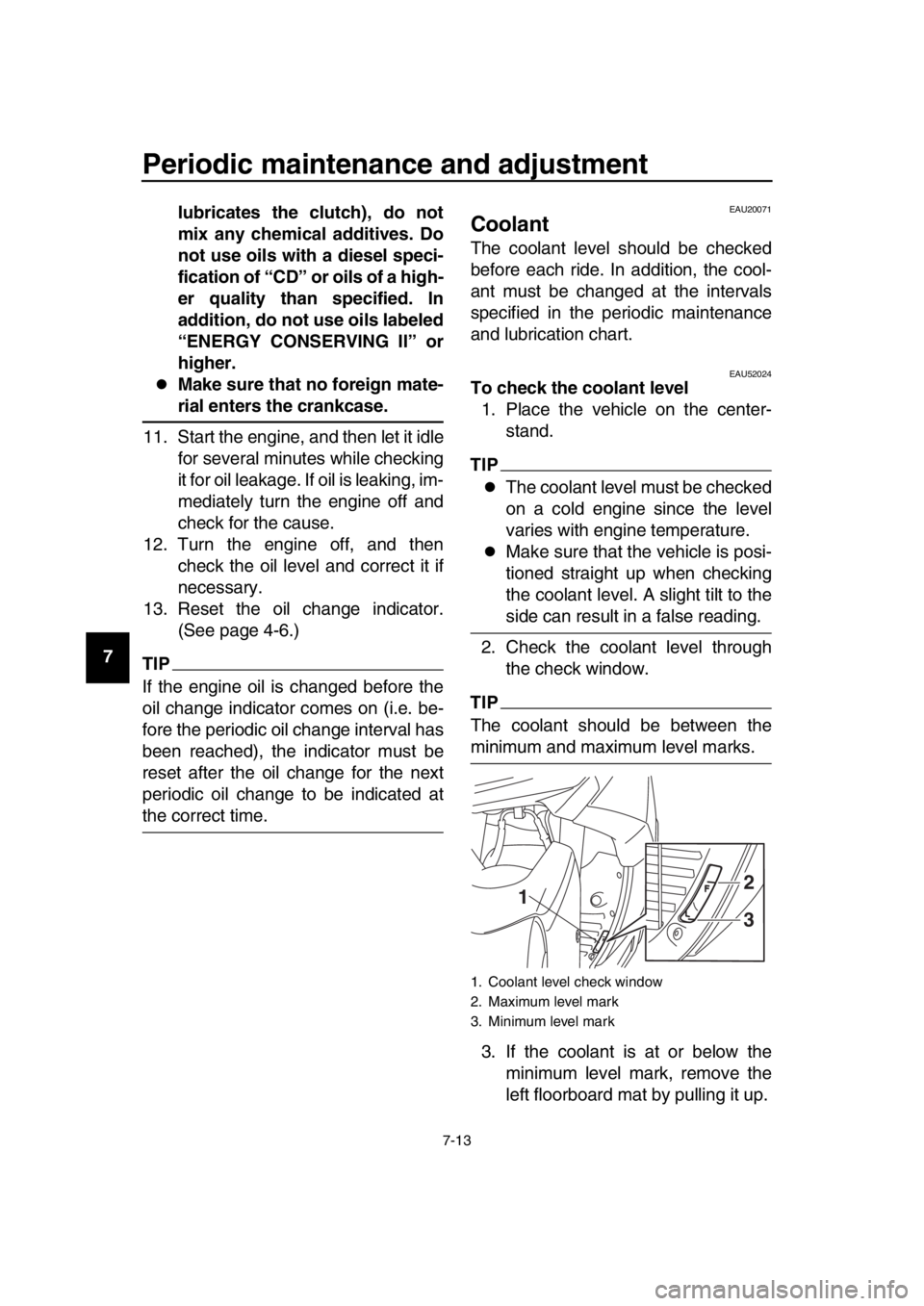
Periodic maintenance and adjustment
7-13
1
2
3
4
5
6
7
8
9
10
11
12
13
14 lubricates the clutch), do not
mix any chemical additives. Do
not use oils with a diesel speci-
fication of “CD” or oils of a high-
er quality than specified. In
addition, do not use oils labeled
“ENERGY CONSERVING II” or
higher.
Make sure that no foreign mate-
rial enters the crankcase.
11. Start the engine, and then let it idle for several minutes while checking
it for oil leakage. If oil is leaking, im-
mediately turn the engine off and
check for the cause.
12. Turn the engine off, and then check the oil level and correct it if
necessary.
13. Reset the oil change indicator. (See page 4-6.)
TIP
If the engine oil is changed before the
oil change indicator comes on (i.e. be-
fore the periodic oil change interval has
been reached), the indicator must be
reset after the oil change for the next
periodic oil change to be indicated at
the correct time.
EAU20071
Coolant
The coolant level should be checked
before each ride. In addition, the cool-
ant must be changed at the intervals
specified in the periodic maintenance
and lubrication chart.
EAU52024To check the coolant level1. Place the vehicle on the center- stand.
TIP
The coolant level must be checked
on a cold engine since the level
varies with engine temperature.
Make sure that the vehicle is posi-
tioned straight up when checking
the coolant level. A slight tilt to the
side can result in a false reading.
2. Check the coolant level through the check window.
TIP
The coolant should be between the
minimum and maximum level marks.
3. If the coolant is at or below the minimum level mark, remove the
left floorboard mat by pulling it up.
1. Coolant level check window
2. Maximum level mark
3. Minimum level mark
12
3
2PW-9-E1.book 13 ページ 2015年9月10日 木曜日 午後5時17分